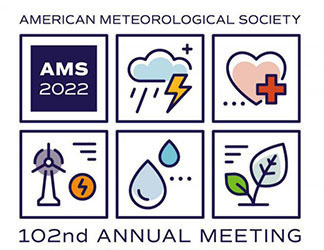
The 2022 American Meteorological Society (AMS) Annual Meeting will be held virtually from January 23 to 27, 2022. The meeting theme is “Environmental Security: Weather, water, and climate for a more secure world.”
- Go here to find ASR-related presentations and posters.
- Visit this page for Atmospheric Radiation Measurement (ARM) user facility-related presentations and posters.
- Add your AMS presentation here to be featured on the ASR or ARM presentation web pages.
During AMS, follow the ARM on Twitter (@armnewsteam) and Facebook (@arm.gov) for a real-time guide to ARM- and ASR-relevant activities. You can track us using the hashtags #ARMAGU, #ASRnews, and #AGU21.
AMS Annual Meeting at a Glance
Note: All times Central; AMS login might be required to view abstract pages.
Joint Panel Discussion
Joint Panel Discussion 12 – Artificial Intelligence for Earth System Predictability (AI4ESP): How Do We Affect a Paradigm Shift in Earth System Modeling Using AI?
Wednesday, January 26, 3:45 p.m. to 5 p.m.
Invited Presentations
Please note: On average, presentations are scheduled to run for fifteen minutes, so the full session times are listed below for planning purposes.
10A.2: The Seasonal Contrast of Aerosols That Can Seed Ice Formation in Central Arctic Clouds
Jessie Creamean, Colorado State University.
Wednesday, January 26, 10:45 a.m. to noon
10A.5: Insights on Sources and Formation Mechanisms of Central Arctic Supercooled Clouds
Israel Silber, Pennsylvania State University.
Wednesday, January 26, 10:45 a.m. to noon
13A.1: Enhancing Aerosol Predictions on the Global Scale With Particle-Resolved Modeling and Machine Learning
Nicole Riemer, University of Illinois at Urbana-Champaign.
Thursday, January 27, 8:30 to 10 a.m.
Featured Field Campaigns
Please note: On average, presentations are scheduled to run for fifteen minutes, so the full session times are listed below for planning purposes.
Tracking Aerosol Convection Interactions ExpeRiment (TRACER)
1ii (Oral): Addressing Air Quality Challenges at Urban-Land-Water Interfaces During Recent Field Studies. Part 1.
Conveners include TRACER-AQ Co-Principal Investigators John Sullivan and Laura Judd
Monday, January 24, 9:15 to 10 a.m.,
2 (Oral): Addressing Air Quality Challenges at Urban-Land-Water Interfaces During Recent Field Studies. Part II.
Conveners include TRACER-AQ Co-Principal Investigators John Sullivan and Laura Judd
Monday, January 24, 10:45 a.m. to noon
3 (Oral): Addressing Air Quality Challenges at Urban-Land-Water Interfaces During Recent Field Studies. Part III.
Conveners include TRACER-AQ Co-Principal Investigator John Sullivan
Monday, January 24, 1:30 to 3 p.m.
Related TRACER presentation:
3.6: Overview of the Pandora Deployment and Analysis of Spatial NO2 Gradients During TRACER-AQ.
97 (Poster): How Meteorological Events Affected Houston’s Air Quality During TRACER-AQ.
Monday, January 24, 5 to 6:30 p.m.
5B (Oral): Regional Air Quality. Part V.
Tuesday, January 25, 8:30 to 10 a.m.
Related TRACER presentation:
5B.4: Observation of O3 Events With LMOL During the TRACER-AQ Campaign.
6B (Oral): Aerosol-Cloud Interactions in Deep Convective Clouds. Part III.
Conveners include TRACER Principal Investigator Michael P. Jensen
Tuesday, January 25, 10:45 a.m. to noon
Reported TRACER presentations:
6B.2: Linking Synoptic Patters to Cloud Properties and Local Circulations Over the TRACER Domain in Houston, Texas.
6B.3: Summary of First Light Observations From the TRacking Aerosol Convection interactions ExpeRiment (TRACER).
7B (Oral): Aerosol-Cloud Interactions in Deep Convective Clouds. Part I.
Conveners include TRACER Principal Investigator Michael P. Jensen
Tuesday, January 25, 1:30 to 3 p.m.
8B (Oral): Aerosol-Cloud Interactions in Deep Convective Clouds. Part II.
Conveners include TRACER Principal Investigator Michael P. Jensen
Tuesday, January 25, 3:45 to 5 p.m.
11A (Panel Discussion): Clouds, Aerosol, and Air Quality in the Coastal Urban Environment: Interagency Field Campaigns in the Houston, Texas Region during 2021–2022.
Discussion will cover TRACER and related field campaigns.
Wednesday, January 26, 1:30 to 3 p.m.
Cloud, Aerosol, and Complex Terrain Interactions (CACTI)
4A (Oral): Aerosol-Cloud Interactions in Warm Clouds. Part IV.
Monday, January 24, 3:45 to 5 p.m.
Related CACTI presentation:
4A.1: Cloud Droplet Clustering and Cloud Droplet Spectral Broadening in Turbulent Clouds Observed During HI-SCALE and CACTI.
146 (Poster): Environments Supporting Deep Convection Initiation During the CACTI Campaign.
Monday, January 24, 5 to 6:30 p.m.
345 (Poster): Estimation and Meteorological Analysis of CCN During RELAMPAGO-CACTI in Córdoba, Argentina.
Tuesday, January 25, 5 to 6:30 p.m.
11 (Oral): Radar Observations of Deep Convection Around the World.
Wednesday, January 26, 1:30 to 3 p.m.
Related CACTI presentation:
11.3: C-Band Polarimetric-Hail Detection in Subtropical South America Using Synthetic Radar Data and RELAMPAGO-CACTI Observations.
513 (Poster): Agricultural Sources of Ice-Nucleating Particles in Argentina During the DOE-ARM Cloud, Aerosol, and Complex Terrain Interactions (CACTI) Experiment.
Wednesday, January 26, 5 to 6:30 p.m.
14 (Oral): Mesoscale Convective Systems.
Thursday, January 27, 10:45 a.m. to noon
Related CACTI presentation:
14.2: Observations of the Discrete Propagation of a Mesoscale Convective System During RELAMPAGO-CACTI.
16 (Oral): Mesoscale Processes Near Orography.
Thursday, January 27, 3:45 to 5 p.m.
Reported ARM CACTI presentation:
16.2: Characteristics and Environmental Controls of the Convective Cell Evolution During CACTI.
This work was supported by the U.S. Department of Energy’s Office of Science, through the Biological and Environmental Research program as part of the Atmospheric System Research program.

